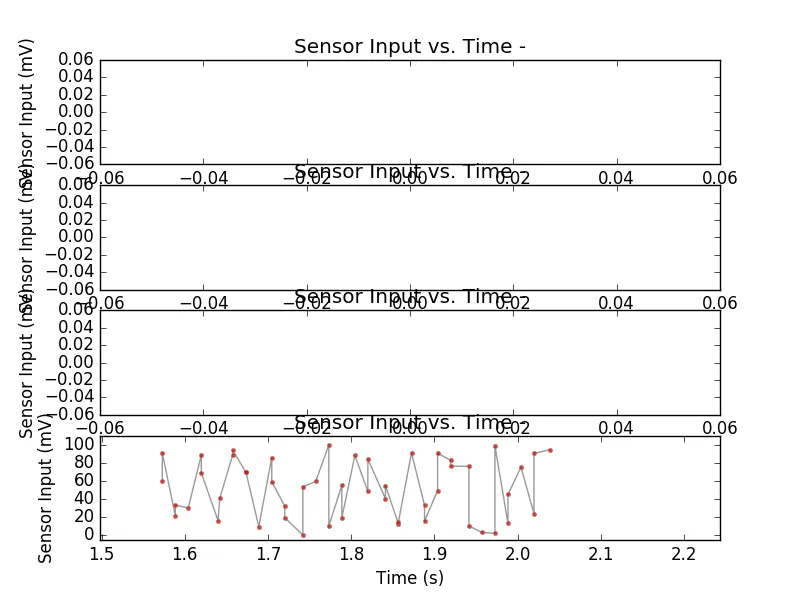我正在尝试在我的Python应用程序中实时绘制多个子图。理想情况下,我还应该能够在每个子图中绘制多条线,但为了简单起见,我假设每个子图只有一条线。 为了高效地实现这一点(我正在寻找快速绘图),我正在尝试将我在网上找到的一个例子(https://taher-zadeh.com/speeding-matplotlib-plotting-times-real-time-monitoring-purposes/)扩展到我的情况。我的代码是:
import time
# for Mac OSX
import matplotlib
matplotlib.use('TkAgg')
import matplotlib.pylab as plt
import random
def test_fps(use_blit=True):
ax1.cla()
ax1.set_title('Sensor Input vs. Time -')
ax1.set_xlabel('Time (s)')
ax1.set_ylabel('Sensor Input (mV)')
ax2.cla()
ax2.set_title('Sensor Input vs. Time -' )
ax2.set_xlabel('Time (s)')
ax2.set_ylabel('Sensor Input (mV)')
ax3.cla()
ax3.set_title('Sensor Input vs. Time -')
ax3.set_xlabel('Time (s)')
ax3.set_ylabel('Sensor Input (mV)')
ax4.cla()
ax4.set_title('Sensor Input vs. Time -')
ax4.set_xlabel('Time (s)')
ax4.set_ylabel('Sensor Input (mV)')
plt.ion() # Set interactive mode ON, so matplotlib will not be blocking the window
plt.show(False) # Set to false so that the code doesn't stop here
cur_time = time.time()
ax1.hold(True)
ax2.hold(True)
ax3.hold(True)
ax4.hold(True)
x, y = [], []
times = [time.time() - cur_time] # Create blank array to hold time values
y.append(0)
line1, = ax1.plot(times, y, '.-', alpha=0.8, color="gray", markerfacecolor="red")
line2, = ax2.plot(times, y, '.-', alpha=0.8, color="gray", markerfacecolor="red")
line3, = ax3.plot(times, y, '.-', alpha=0.8, color="gray", markerfacecolor="red")
line4, = ax4.plot(times, y, '.-', alpha=0.8, color="gray", markerfacecolor="red")
fig.show()
fig.canvas.draw()
if use_blit:
background1 = fig.canvas.copy_from_bbox(ax1.bbox) # cache the background
background2 = fig.canvas.copy_from_bbox(ax2.bbox) # cache the background
background3 = fig.canvas.copy_from_bbox(ax3.bbox) # cache the background
background4 = fig.canvas.copy_from_bbox(ax4.bbox) # cache the background
tic = time.time()
niter = 200
i = 0
while i < niter:
fields = random.random() * 100
times.append(time.time() - cur_time)
y.append(fields)
# this removes the tail of the data so you can run for long hours. You can cache this
# and store it in a pickle variable in parallel.
if len(times) > 50:
del y[0]
del times[0]
xmin, xmax, ymin, ymax = [min(times) / 1.05, max(times) * 1.1, -5,110]
# feed the new data to the plot and set the axis limits again
plt.axis([xmin, xmax, ymin, ymax])
if use_blit:
fig.canvas.restore_region(background1) # restore background
line1.set_xdata(times)
line1.set_ydata(y)
ax1.draw_artist(line1) # redraw just the points
fig.canvas.blit(ax1.bbox) # fill in the axes rectangle
fig.canvas.restore_region(background2) # restore background
line2.set_xdata(times)
line2.set_ydata(y)
ax2.draw_artist(line2) # redraw just the points
fig.canvas.blit(ax2.bbox)
fig.canvas.restore_region(background3) # restore background
line3.set_xdata(times)
line3.set_ydata(y)
ax3.draw_artist(line3) # redraw just the points
fig.canvas.blit(ax3.bbox)
fig.canvas.restore_region(background4) # restore background
line4.set_xdata(times)
line4.set_ydata(y)
ax4.draw_artist(line4) # redraw just the points
fig.canvas.blit(ax4.bbox)
else:
fig.canvas.draw()
fig.canvas.flush_events()
i += 1
fps = niter / (time.time() - tic)
return fps
并且
fig = plt.figure()
ax1 = fig.add_subplot(4, 1, 1)
ax2 = fig.add_subplot(4, 1, 2)
ax3 = fig.add_subplot(4, 1, 3)
ax4 = fig.add_subplot(4, 1, 4)
fps1 = test_fps(use_blit=True)
这段代码的问题在于它只在最后一个子图上绘制,其它子图则留空。
我刚接触Python,这可能是一个很愚蠢的问题,但我还没有搞清楚,所以任何提示对我都非常有帮助。谢谢
